Information injection-pump assembly
BOSCH
9 400 612 722
9400612722
ZEXEL
107692-1670
1076921670

Rating:
Service parts 107692-1670 INJECTION-PUMP ASSEMBLY:
1.
_
5.
AUTOM. ADVANCE MECHANIS
7.
COUPLING PLATE
11.
Nozzle and Holder
8-94390-795-4
12.
Open Pre:MPa(Kqf/cm2)
18.1{185}/22.1{225}
14.
NOZZLE
Include in #1:
107692-1670
as INJECTION-PUMP ASSEMBLY
Cross reference number
BOSCH
9 400 612 722
9400612722
ZEXEL
107692-1670
1076921670
Zexel num
Bosch num
Firm num
Name
Calibration Data:
Adjustment conditions
Test oil
1404 Test oil ISO4113 or {SAEJ967d}
1404 Test oil ISO4113 or {SAEJ967d}
Test oil temperature
degC
40
40
45
Nozzle and nozzle holder
105780-8250
Bosch type code
1 688 901 101
Nozzle
105780-0120
Bosch type code
1 688 901 990
Nozzle holder
105780-2190
Opening pressure
MPa
20.7
Opening pressure
kgf/cm2
211
Injection pipe
Outer diameter - inner diameter - length (mm) mm 8-3-600
Outer diameter - inner diameter - length (mm) mm 8-3-600
Overflow valve
131425-1820
Overflow valve opening pressure
kPa
255
255
255
Overflow valve opening pressure
kgf/cm2
2.6
2.6
2.6
Tester oil delivery pressure
kPa
255
255
255
Tester oil delivery pressure
kgf/cm2
2.6
2.6
2.6
PS/ACT control unit part no.
407980-2
24*
Digi switch no.
17
Direction of rotation (viewed from drive side)
Left L
Left L
Injection timing adjustment
Direction of rotation (viewed from drive side)
Left L
Left L
Injection order
1-5-3-6-
2-4
Pre-stroke
mm
5.1
5.07
5.13
Beginning of injection position
Governor side NO.1
Governor side NO.1
Difference between angles 1
Cal 1-5 deg. 60 59.75 60.25
Cal 1-5 deg. 60 59.75 60.25
Difference between angles 2
Cal 1-3 deg. 120 119.75 120.25
Cal 1-3 deg. 120 119.75 120.25
Difference between angles 3
Cal 1-6 deg. 180 179.75 180.25
Cal 1-6 deg. 180 179.75 180.25
Difference between angles 4
Cyl.1-2 deg. 240 239.75 240.25
Cyl.1-2 deg. 240 239.75 240.25
Difference between angles 5
Cal 1-4 deg. 300 299.75 300.25
Cal 1-4 deg. 300 299.75 300.25
Injection quantity adjustment
Adjusting point
-
Rack position
14.2
Pump speed
r/min
850
850
850
Average injection quantity
mm3/st.
114
112.4
115.6
Max. variation between cylinders
%
0
-2.5
2.5
Basic
*
Fixing the rack
*
PS407980-224*
V
2.25+-0.
01
PS407980-224*
mm
3.1+-0.0
5
Standard for adjustment of the maximum variation between cylinders
*
Injection quantity adjustment_02
Adjusting point
Z
Rack position
8.5+-0.5
Pump speed
r/min
435
435
435
Average injection quantity
mm3/st.
9
7.7
10.3
Max. variation between cylinders
%
0
-14
14
Fixing the rack
*
PS407980-224*
V
V1+0.05+
-0.01
PS407980-224*
mm
5+-0.03
Standard for adjustment of the maximum variation between cylinders
*
Remarks
Refer to items regarding the pre-stroke actuator
Refer to items regarding the pre-stroke actuator
Injection quantity adjustment_03
Adjusting point
A
Rack position
R1(14.2)
Pump speed
r/min
850
850
850
Average injection quantity
mm3/st.
114
113
115
Basic
*
Fixing the lever
*
PS407980-224*
V
2.25+-0.
01
PS407980-224*
mm
3.1+-0.0
5
Injection quantity adjustment_04
Adjusting point
B
Rack position
R1+2
Pump speed
r/min
1450
1450
1450
Average injection quantity
mm3/st.
113.5
103.5
123.5
Fixing the lever
*
PS407980-224*
V
2.25+-0.
01
PS407980-224*
mm
3.1+-0.0
5
0000001601
CU407980-224*
*
Actuator retarding type
*
Supply voltage
V
24
23.5
24.5
Ambient temperature
degC
23
18
28
Pre-stroke
mm
2
1.95
2.05
Output voltage
V
2.83
2.82
2.84
Adjustment
*
_02
CU407980-224*
*
Supply voltage
V
24
23.5
24.5
Ambient temperature
degC
23
18
28
Pre-stroke
mm
5.1
5.07
5.13
Output voltage
V
1.2
1
1.4
Confirmation
*
Remarks
Output voltage V1
Output voltage V1
_03
CU407980-224*
*
Supply voltage
V
24
23.5
24.5
Ambient temperature
degC
23
18
28
Output voltage
V
3.05
3.05
Confirmation of operating range
*
Test data Ex:
Governor adjustment
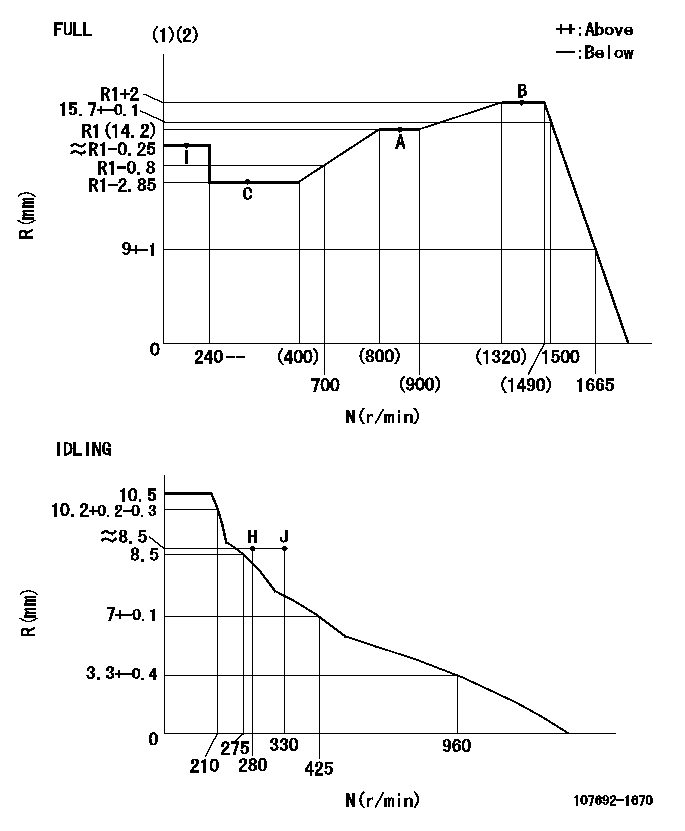
N:Pump speed
R:Rack position (mm)
(1)Torque cam stamping: T1
(2)Tolerance for racks not indicated: +-0.05mm.
----------
T1=AH10
----------
----------
T1=AH10
----------
Speed control lever angle
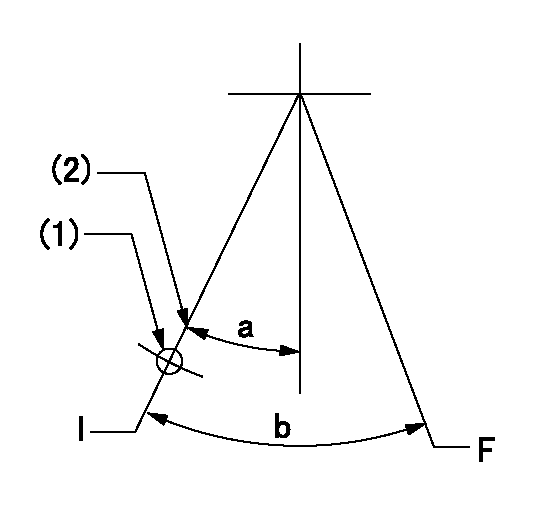
F:Full speed
I:Idle
(1)Use the pin at R = aa
(2)Stopper bolt setting
----------
aa=68mm
----------
a=17deg+-5deg b=36deg+-3deg
----------
aa=68mm
----------
a=17deg+-5deg b=36deg+-3deg
Stop lever angle
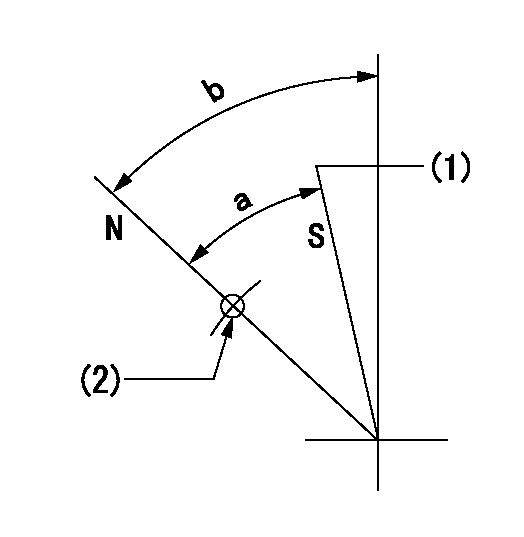
N:Pump normal
S:Stop the pump.
(1)Set the stopper bolt at speed = aa and rack position = bb (non-injection rack position).
(2)Use the pin above R = cc
----------
aa=0r/min bb=1.5+-0.3mm cc=40mm
----------
a=44deg+-5deg b=44deg+-5deg
----------
aa=0r/min bb=1.5+-0.3mm cc=40mm
----------
a=44deg+-5deg b=44deg+-5deg
0000001301
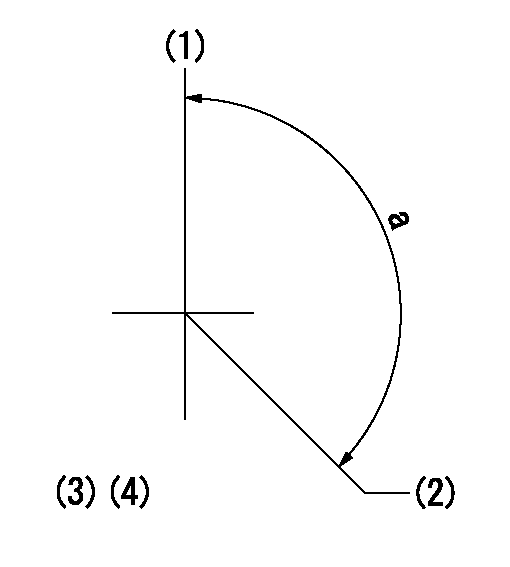
(1)Pump vertical direction
(2)Positions of coupling's threaded installation holes at No 1 cylinder's beginning of injection
(3)B.T.D.C.: aa
(4)Pre-stroke: bb
----------
aa=6deg bb=5.1+-0.03mm
----------
a=(140deg)
----------
aa=6deg bb=5.1+-0.03mm
----------
a=(140deg)
0000001401
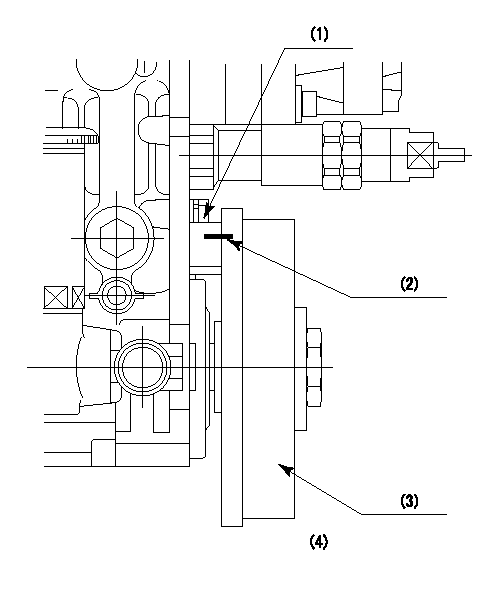
(1)Pointer
(2)Injection timing aligning mark
(3)Fly weight
(4)The actual shape and direction may be different from this illustration.
Operation sequence
1. Turn the prestroke actuator OFF.
2. Turn the camshaft as far as the No.1 cylinder's beginning of injection position.
3. Check that the pointer alignment mark of the injection pump and the alignment mark of the flywheel are matching.
4. If they are not matching, erase the alignment mark on the flywheel side, and stamp an alignment mark on the flywheel position that matches with the pointer side alignment mark.
5. Check again that the coupling's key groove position is in the No.1 cylinder's beginning of injection position.
----------
----------
----------
----------
0000001701
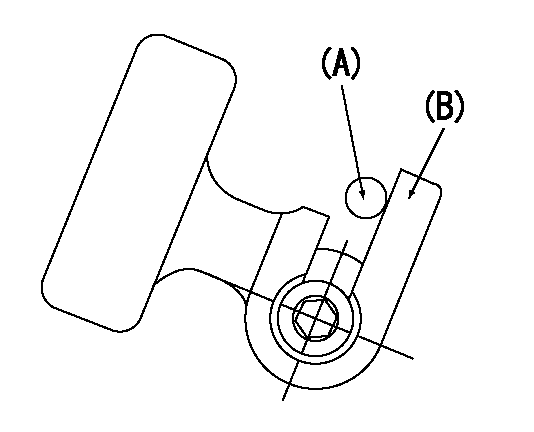
A : Stopper pin
B: Connector
----------
----------
----------
----------
0000001801
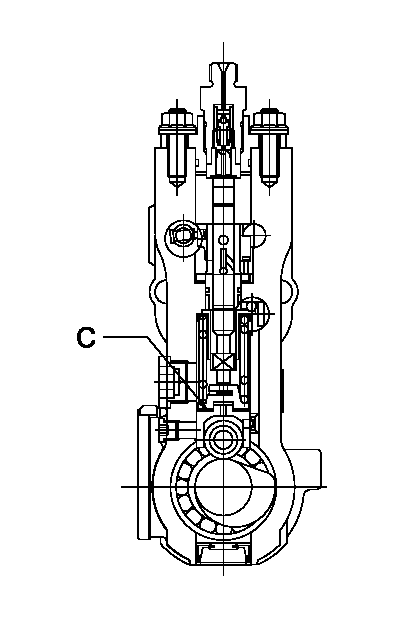
C:Shim
----------
----------
----------
----------
0000001901
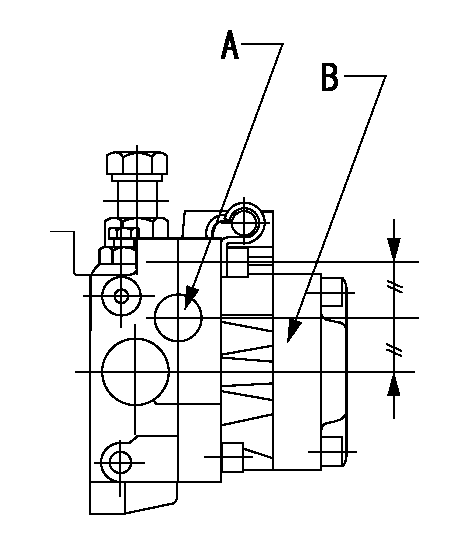
A:Sealing position
B:Pre-stroke actuator
1. When installing the pre-stroke actuator on the pump, first tighten the installation bolts loosely, then move the actuator fully clockwise (viewed from the drive side).
Temporary tightening torque: 1 - 1.5 N.m (0.1 - 0.15 kgf.m)
2. Move the actuator in the counterclockwise direction when viewed from the drive side, and adjust so that it becomes the adjustment point of the adjustment value. Then tighten it.
Tightening torque: 7^9 N.m (0.7^0.9 kgf.m)
3. After prestroke actuator installation adjustment, simultaneously stamp both the actuator side and housing side.
----------
----------
----------
----------
0000002201 RACK SENSOR
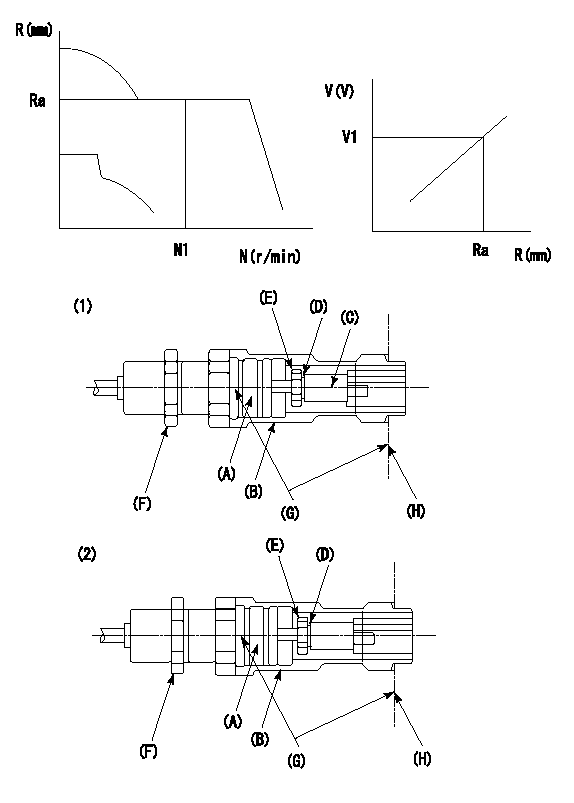
G:Red paint
H:Pump end face
P/N: part number of suitable shim
(1)Threaded type rack block
(2)Welded type rack block
Rack sensor adjustment
1. Threaded type rack sensor (-5*20, P type, no TICS rack limit).
(1)Screw in the bobbin (A) until it contacts the joint (B).
(2)Fix the pump lever.
(3)At speed N1 and rack position Ra, adjust the amount that the bobbin is screwed in so that the amp's output voltage is V1.
(4)Fix using the nut (F).
(5)Affix the caution plate to the upper part of the joint (B).
(6)Apply (G) at two places.
Connecting part between the joint (B) and the nut (F)
Connecting part between the end surface of the pump (H) and the joint (B)
2. Range for screw-in adjustment between the bobbin (A) and the joint (B) is 9 threads.
Screw in to the end from (the position where the bobbin (A) is rotated 9 turns).
Speed N1, rack position Ra, output voltage V1, rack sensor supply voltage 5+-0.01 (V)
----------
Ra=R1(14.2)+2mm N1=1450r/min V1=3+-0.01V
----------
----------
Ra=R1(14.2)+2mm N1=1450r/min V1=3+-0.01V
----------
0000002301 AIR CYLINDER
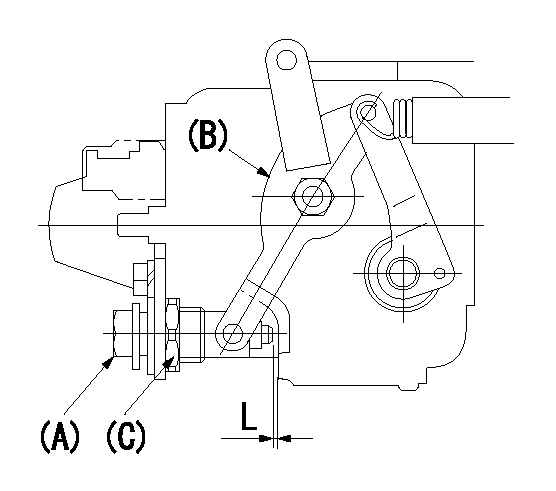
(a) Air cylinder
(b) Speed lever
(c) Lock nut
1. Air cylinder adjustment procedure
(1)Set the speed lever B in the idle position.
(2)Turn the air cylinder A ON.
(3)Screw in the air cylinder (a)
(4)Set the speed lever B so that the speed is N1 and the rack position is Ra.
(5)After setting, turn the air cylinder A off.
(6)Confirm that the distance between the speed lever B and the air cylinder A is approximately L.
----------
N1=325r/min Ra=8.5+-0.1mm L=1mm
----------
----------
N1=325r/min Ra=8.5+-0.1mm L=1mm
----------
Information:
Programmable Features
The PEEC engine has the programmable features of cruise control, PTO governing, vehicle speed limiting, high gears rpm limiting, low gears rpm limiting, TEL rpm limiting, idle shutdown timer and retarder coast/latch included in its functions.Cruise Control
Typical InstallationCruise control reduces driver fatigue and improves vehicle ride by eliminating throttle bounce. Cruise control can also reduce fuel consumption and driver to driver variations in a large fleet.* Vehicle speed MUST be ABOVE the low cruise control speed limit [typically 30 mph (48 km/h)].* Set the ON/OFF switch to the ON position.* Accelerate vehicle to desired speed.* Move the SET/RESUME switch momentarily into the SET position. The engine will maintain the speed that the truck is traveling when the SET switch is released. If the SET switch is held for more than one second, the truck speed will continue to increase until the SET switch is released. The cruise speed will then be set to the speed the truck is traveling when the SET switch is released.* Move the ON/OFF switch to the OFF position, or ...* Depress the clutch pedal, or ...* Depress the service brake pedal.* Return the ON/OFF switch to the ON position, and/or ...*Place the SET/RESUME switch momentarily into the RESUME position. The PEEC system remembers the last cruise control set speed as long as the engine is running.If the RESUME switch is held for more than one second, the PEEC system will decrease the truck speed and a new set speed will be established when the RESUME switch is released.The throttle can be used to exceed the cruise control set speed, if the high cruise limit is lower than the vehicle speed limit. Releasing the throttle will return the truck to the previous cruise speed. The throttle override can be used to anticipate hills or for passing situations.To shift gears, the ON/OFF switch can be moved to the OFF position or disengage the clutch to deactivate the cruise control.After shifting gears, the cruise control can be reactivated by moving the ON/OFF switch to the ON position and/or momentarily setting the SET/RESUME switch in the RESUME position. The PEEC system may have a maximum cruise speed which has been specified by the owner of the truck. The cruise control will only function between the programmed Low Cruise Control Limit (LCC) and High Cruise Control Limit (HCC). The High Cruise Control set limit is also generally set at a lower mph (km/h) than the vehicle speed limit.PTO Governor Mode
The cruise control function of the PEEC system works as a PTO governor or engine speed governor when the vehicle is stationary or when operated at a vehicle speed below the PTO Vehicle Speed Limit (PTO VSL). Activation and deactivation of the PTO governor is the same as the cruise control.The PTO governor will operate at any engine rpm from low idle to the maximum PTO limit rpm (which is usually less than rated engine rpm). The maximum PTO governor speed is a customer specified parameter.* To operate
The PEEC engine has the programmable features of cruise control, PTO governing, vehicle speed limiting, high gears rpm limiting, low gears rpm limiting, TEL rpm limiting, idle shutdown timer and retarder coast/latch included in its functions.Cruise Control
Typical InstallationCruise control reduces driver fatigue and improves vehicle ride by eliminating throttle bounce. Cruise control can also reduce fuel consumption and driver to driver variations in a large fleet.* Vehicle speed MUST be ABOVE the low cruise control speed limit [typically 30 mph (48 km/h)].* Set the ON/OFF switch to the ON position.* Accelerate vehicle to desired speed.* Move the SET/RESUME switch momentarily into the SET position. The engine will maintain the speed that the truck is traveling when the SET switch is released. If the SET switch is held for more than one second, the truck speed will continue to increase until the SET switch is released. The cruise speed will then be set to the speed the truck is traveling when the SET switch is released.* Move the ON/OFF switch to the OFF position, or ...* Depress the clutch pedal, or ...* Depress the service brake pedal.* Return the ON/OFF switch to the ON position, and/or ...*Place the SET/RESUME switch momentarily into the RESUME position. The PEEC system remembers the last cruise control set speed as long as the engine is running.If the RESUME switch is held for more than one second, the PEEC system will decrease the truck speed and a new set speed will be established when the RESUME switch is released.The throttle can be used to exceed the cruise control set speed, if the high cruise limit is lower than the vehicle speed limit. Releasing the throttle will return the truck to the previous cruise speed. The throttle override can be used to anticipate hills or for passing situations.To shift gears, the ON/OFF switch can be moved to the OFF position or disengage the clutch to deactivate the cruise control.After shifting gears, the cruise control can be reactivated by moving the ON/OFF switch to the ON position and/or momentarily setting the SET/RESUME switch in the RESUME position. The PEEC system may have a maximum cruise speed which has been specified by the owner of the truck. The cruise control will only function between the programmed Low Cruise Control Limit (LCC) and High Cruise Control Limit (HCC). The High Cruise Control set limit is also generally set at a lower mph (km/h) than the vehicle speed limit.PTO Governor Mode
The cruise control function of the PEEC system works as a PTO governor or engine speed governor when the vehicle is stationary or when operated at a vehicle speed below the PTO Vehicle Speed Limit (PTO VSL). Activation and deactivation of the PTO governor is the same as the cruise control.The PTO governor will operate at any engine rpm from low idle to the maximum PTO limit rpm (which is usually less than rated engine rpm). The maximum PTO governor speed is a customer specified parameter.* To operate